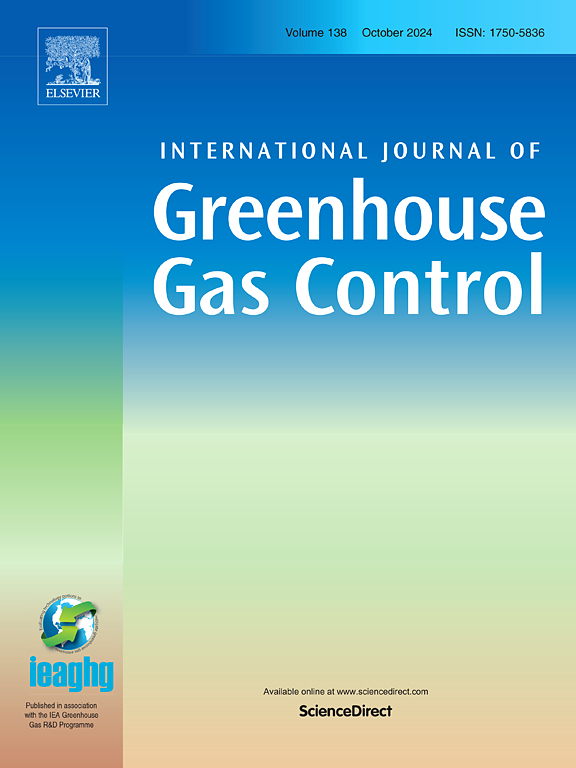Calibrating large-scale injection: Using saltwater disposal experience to predict CCS performance on the Texas Gulf Coast
IF 5.2
3区 工程技术
Q2 ENERGY & FUELS
International Journal of Greenhouse Gas Control
Pub Date : 2025-10-01
DOI:10.1016/j.ijggc.2025.104485
引用次数: 0
Abstract
Over 50 geologic carbon storage (GCS) projects are now advancing on the US Gulf Coast. Comparing their stated goals with the number of currently permitted wells suggests some planned injection rates over 5Mtpa/well. Modelling supports these numbers, but Gulf Coast reservoirs are structurally and stratigraphically complicated, with potential for compartmentalization that may lead to unanticipated pressure buildup and premature loss of injectivity. We seek to calibrate that risk by looking at historical saltwater disposal (SWD) on the Texas Gulf Coast. From 1990 to 2020, over 20 billion barrels of brine (∼2 Gt CO2-equivalent) were injected into non-productive reservoirs, largely without adverse effect. Analysis of injectivity index for these wells shows that most are poor performers in lifetime average terms, with few wells clearly capable of 1Mtpa CO2-equivalent. However, intermittent injection, not captured by the data, may explain apparently poor performance. Analysis of monthly injectivity index shows that over half the wells had at least one month indicative of >1Mtpa CO2-equivalent capability. Anecdotal evidence, and even our analysis, suggests that all wells eventually lose injectivity, but we can see no evidence of pressure buildup or declining performance at the formation level. More commonly, the cause seems to be formation damage, apparently mostly resulting from impurities in the injected brines—microbes, incompatible chemistry and/or entrained solids. We believe that GCS wells are likely to perform better than SWD wells, owing to better location, superior planning, and a cleaner injection stream. These results suggest cautious optimism for large-scale GCS on the Gulf Coast.
校准大规模注入:利用盐水处理经验预测德克萨斯州墨西哥湾沿岸的CCS性能
超过50个地质碳储存(GCS)项目目前正在美国墨西哥湾沿岸推进。将他们的既定目标与目前允许的井数量进行比较,可以发现一些计划的注入速度超过500万吨/井。建模支持这些数据,但墨西哥湾沿岸的储层结构和地层复杂,可能存在分隔,导致意外的压力积聚和过早的注入能力丧失。我们试图通过观察德克萨斯州墨西哥湾沿岸历史上的盐水处理(SWD)来校准这种风险。从1990年到2020年,超过200亿桶盐水(相当于2亿吨二氧化碳当量)被注入非生产油藏,基本上没有产生不利影响。对这些井的注入能力指数分析表明,从平均寿命来看,大多数井表现不佳,只有少数井能够产生100万吨/年的二氧化碳当量。然而,数据中没有捕捉到的间歇性注射可能是性能明显不佳的原因。月度注入能力指数分析显示,超过一半的井至少有一个月的二氧化碳当量能力。坊间的证据,甚至我们的分析都表明,所有的井最终都会失去注入能力,但我们没有看到地层压力升高或性能下降的证据。更常见的原因似乎是地层受损,显然主要是由于注入盐水中的杂质、微生物、不相容的化学物质和/或夹带的固体。我们认为,GCS井可能比SWD井表现更好,因为GCS井有更好的位置、更好的规划和更清洁的注入流。这些结果表明对墨西哥湾沿岸的大规模GCS持谨慎乐观态度。
本文章由计算机程序翻译,如有差异,请以英文原文为准。
求助全文
约1分钟内获得全文
求助全文
来源期刊
CiteScore
9.20
自引率
10.30%
发文量
199
审稿时长
4.8 months
期刊介绍:
The International Journal of Greenhouse Gas Control is a peer reviewed journal focusing on scientific and engineering developments in greenhouse gas control through capture and storage at large stationary emitters in the power sector and in other major resource, manufacturing and production industries. The Journal covers all greenhouse gas emissions within the power and industrial sectors, and comprises both technical and non-technical related literature in one volume. Original research, review and comments papers are included.

 求助内容:
求助内容: 应助结果提醒方式:
应助结果提醒方式:


